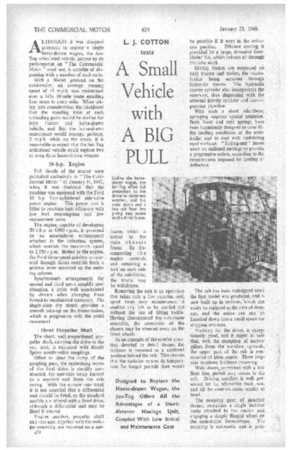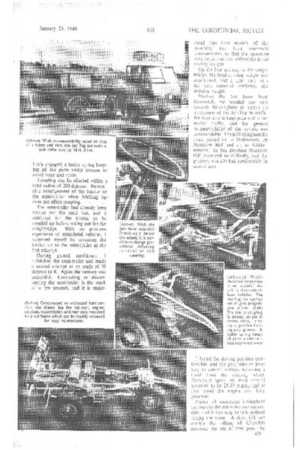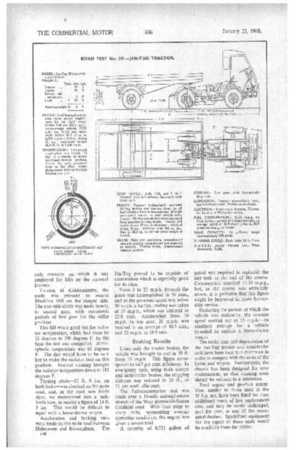L. J. COTTON tests
Page 30

Page 31

Page 32

If you've noticed an error in this article please click here to report it so we can fix it.
A Small Vehicle • with A BIG PULL
ALTHOUGH it was designed primarily to replace' a single horse-drawn wagon, the JenTug articulated vehicle, judged by its performance on "The Commercial Motor" road test, is capable of dispensing with a number of such carts.
With a 30-cwt. payload on the semi-trailer, an average running speed of 15 m.p.h. was maintained over a hilly 10-mile route entailing four stops to every mile. When taking into consideration the likelihood that the standing time at each unloading point would be similar for both tractor and horse-drawn vehicle, and that the horse-drawn Conveyance would average, perhaps, 2 m.p.h while on the move, it is reasonable to expect that the Jen-Tug articulated vehicle could replace two or even three horse-drawn wagons.
10-h.p. Engine Full details of the tractor were published exclusively in "The Commercial Motor" of January 31, 1947, when It was disclosed that the machine was equipped with the Ford 10 hp. four-cylindered side-valve
petrol. engine. This power unit is fitted to combine high efficiency with low fuel consumption and low replacement costs.
The engine, capable of developing 30 b.h p. at 4,000 r.p.m., is governed by an atmospheric arrangement attached to the induction system., whichrestricts the maximum speed to 2,750 r.p.m. Bolted to the engine, the Ford three-speed gearbox is operated through Arens controls from a selector lever mounted on the steering column.
Synchromesh arrangements for second and third gears simplify gear changing, a point well appreciated by drivers when changing from horsed to mechanized transport. The single-plate dry clutch provides a smooth take-up on the transmission, which is progressive with the pedal movement • Short Propeller Shaft The short, well-proportioned propeller shaft, carrying the drive to the rear axle, is equipped with Hardy Spicer needle-roller couplings.
Offset to clear the ramp of the coupling gear, the underslung worm of the final drive is sturdily constructed, the assembly being formed as a separate unit from the axle casing. With the narrow rear track it is not essential that a differential unit should be fitted, so the standard models ale offered with a fixed drive, although a differential unit may be fitted if desired Engine, gearbox, propeller shaft and rear axle, together with the radiator assembly, are mounted on a sub A2$ frame, which is bolted to the main chassis frame. By disconnecting t h engine controls and removing a bolt on each side of the sub-frame, the whole may . be withdrawn.
Removing the unit is an operation that takes only a few minutes, and, apart from easy maintenance, it enables any job to be carried out without the use of lifting tackle. Having disconnected the sub-frame assembly, the remainder of the chassis may be wheeled away on the front wheels.
As an example of the careful attention devoted to detail design, the radiator is mounted in a sheltered position behind the cab. This ensures that the radiator retains its temperature for longer periods than would be possible if it were in the ortho dox position. Efficient cooling is provided by a large, shrouded four. bladed fan, which induces air through the tube stack.
Girlirig brakes are employed on both tractor and trailer, the tractor brakes being actuated through hydraulic means. The hydraulic master cylinder also incorporates the reservoir, thus dispensing with the external gravity cylinder and accompanying pipe-line.
With such a short wheelbase, springing requires special attention. Both front and rear springs have been ingeniously designed to cater for the loading conditions of the semitrailer and to deal with undulating road surfaces. " Sliding-end " leaves work on radiused seatings to provide a progressive action, according to the requirements imposed by loading or deflection.
The cab has been redesigned since the first model was produced, and is now built up in sections, Which can easily be replaced in the case of damage, and the entire Cab can be knocked down into ia small space for shipping overseas.
" . Visibility for the driver, is excep:tionally good, and it might be said that, with the exception of narrow pillars from the waistline .upwards, the upper part of . the cab is constructed of glass panels. Three large rear windows facilitate reversing.
Wide doors5 combined with a low floor line, permit easy access to the cab. Driving comfort is well preserved by an adjustable back rest, and all the controls come readily to hand.
The coupling gear, of patented design, comprises a single inclined ramp attached to the tractor . and engaging a deeply flanged wheel on the . semi-trailer forecarriage. The coupling is. automatic and is posi
lively engaged, a buffer spring keeping all the parts under tension to avoid wear and rattle.
Coupling can be effected within a total radius of 200 degrees. Reasonable misalignment of the tractor to the semi-trailer when hitching up does not affect coupling.
The semi-trailer had already been loaded for the road test, and it remained for the tractor to be coupled up before setting out for the weighbridge. With no previous experience of articulated vehicles, I surprised myself by reversing the tractor on to the semi-trailer at the first attempt.
Having gained confidence, I unhitched the semi-trailer and made a second attempt at an angle of 90 degrees to it. Again the venture was
successful. Connecting Or discOnnecting the semi-trailer is the work of a few seconds, and it is under
stood that later models off the assembly line have automatic arrangements, so that the operation may be carried out without the driver leaving his cab On the first journey to the weighbridge, the total running weight was ascertained, and a later visit with the load removed confirmed the unladen weight.
Starting the test from West Bromwich, we wended our way towards Birmingham to obtain an impression of the Jen-Tug in traffic. We were able to keep pace with other motor traffic, and the general manieuvrability of the vehicle was :ommendable. From Birmingham the route passed on to Halesowen, up Mucklow Hill and on to Kidderminster. In this direction Mucklow Hill presented no difficulty, and the gradient was climbed comfortably in second gear
I found the driving position comfortable, and the gear selector lever easy to control without removing a hand from the steering wheel. Maximum speed on level ground appeared to be 25-27 m.p.h., and at that speed the engine was fully governed.
Under all conditions throughout the journey the cab noise was reasonable, and it was easy to talk without raising the voice. A short hill just outside the village of Churchill enforced the use of first gear, the only occasion on which it was employed for hills on the outward journey.
Turning at Kidderminster, the route was retraced to ascend Mucklow Hill on the steeper side. The one-mile climb was made mostly. in second gear, with occasional periods of first gear for the stiffer gradient.
This hill was a good test for radiator temperature, which had risen by 18 degrees to 198 degrees F. by the time the test was completed. Atmospheric temperature was 61 degrees F. The day would have to be very hot to make the radiator boil on this gradient. Normal running brought the radiator temperature down to 182 degrees F.
Turning circle-22 ft. 9 ins. on both locks—was checked on the main road, arid, as the road was fairly clear, we manoeuvred into a jackknife turn, to record a figure of 14 ft. 3 ins. This would be difficult to equal with a horse-drawn wagon.
Acceleration and braking tests were made on the main road between Halesowen and Birmingham. The A30 Jen-Tug proved to be capable of acceleration which is especially good for its class.
From 0 to 20 m.p.h. through the gears was accomplished in 16 secs., and as the governed speed was below 30 m.p.h. a further reading was taken at 25 m.p.h., which was attained in 25.8 secs. Accelerating from 10 m.p.h. in top gear, 20 m.p.h. was reached in an average of 10.5 secs., and 25 m.p.h. in 18.9 secs.
Braking Results Using only the tractor brakes, the vehicle was brought to rest in 30 ft. from 20 m.p.h. This figure corresponds to 44.7 per cent. efficiency. In emergency tests, using both tractor and semi-trailer brakes, the stopping distance was reduced to 26 ft., or 51 per cent. efficiency.
The fuel-consumption test was made over a 10-mile out-and-return stretch of the West Bromwich-Sutton Coldfield road. With four stops to every mile, representing average operating conditions, the engine was given a severe trial.
A quantity of 0.751 gallon of petrol was required to replenish the test tank at the end of the course. Consumption equalled 13.33 m.p.g., but, as the course was extremely severe, it is probable that this figure might be improved in more favourable service.
Deducting the periods at which the vehicle was stationary, the average speed worked out at 15 m.p.h.—an excellent average for a vehicle intended to replace a horse-drawn wagon.
The initial cost and depreciation of the Jen-Tug tractor and semi-trailer unit have been kept to a minimum in order to compete with the costs of the horse and wagon. Furthermore, the chassis has been designed for easy maintenance, so that running costs should be reduced to a minimum.
Ford engine and gearbox assemblies, similar to those used in the 10 h.p. car, have been fitted for their additional merit of low replacement cost, and may be easily exchanged, part for part, at any of the recognized dealers. Specialized equipment for the repair of these units would be available from the dealer.












































































